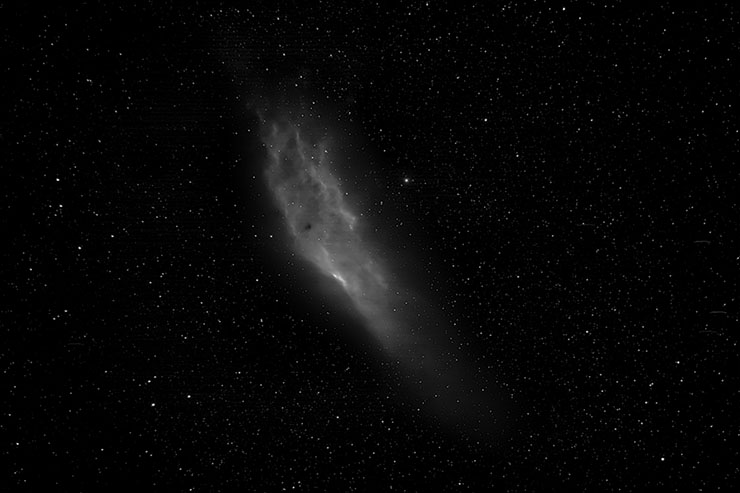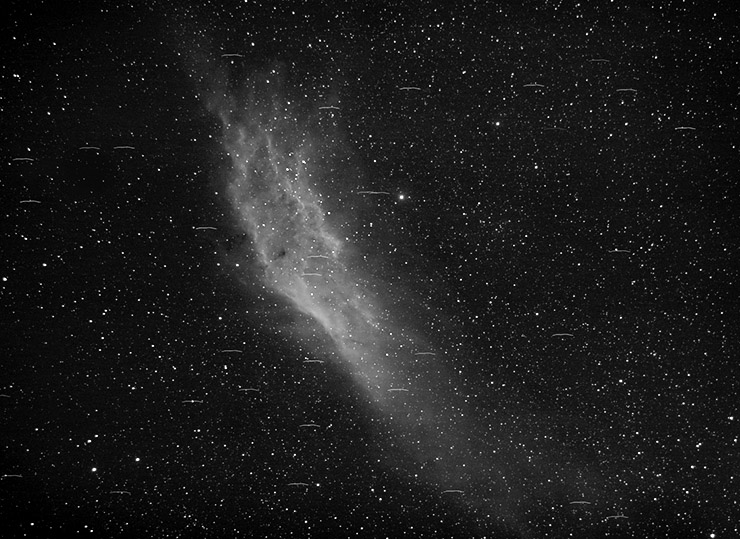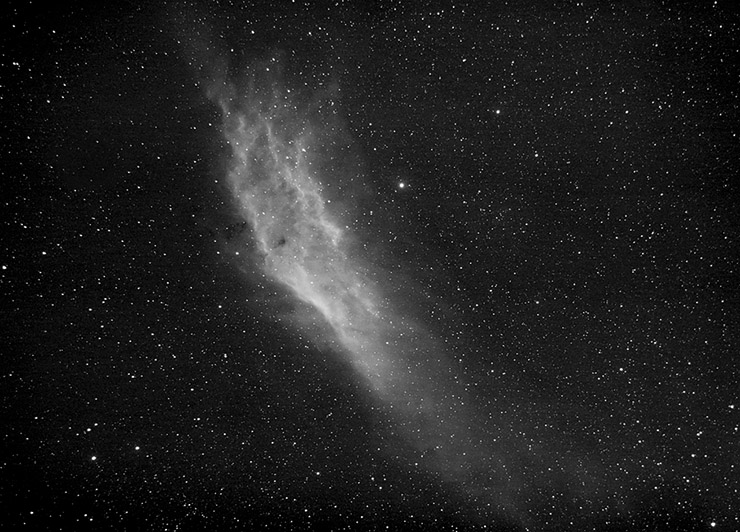|
|
Nothing particularly dramatic tonight (11/27/2009): Mostly just making sure that what worked before is repeatable. So I aimed at NGC 7000, the North America nebula, with the 200mm F2.0 on the modified 20D with the Astronomik 12nm H-a filter. I did not refocus. Three changes: the camera was powered by the aftermarket battery grip (with 2 Canon batteries inside), the release was the aftermarket 803 knockoff, and the lens was stopped to F2.8. I know that seems to defeat the whole point of having an F2.0 lens, but look at the results:
Click the image for a larger view. 46x93 sec = 4,278s = 1h 11m 18s
I got your Black Friday right here: finally, sharp stars and a vastly less troublesome hotspot. And I think we're getting plenty of light, no? This is not too shabby considering that a well-past-half Moon was lighting up the yard and the sky. About the odd exposure length: I set the timer to do 50 subframes, but the batteries gave out after 43. The 93-second exposures were supposed to be 100-second exposures, but I fumbled with the controller in the dark and accidentally reset it to 93. I wanted 5,000 seconds, got a little less. Here's the same frame inverted to show off the faintest nebulosity and to emphasize the dark clouds in the area:
The camera collected that data while we ate Thanksgiving dinner a day late; Maxim DL5 processed it while we watched the Peanuts Thanksgiving special. I plugged up the Canon AC adapter and had the camera collect light from NGC 1499, the California Nebula, while I played with the images above. This one was not quite so successful. The target is fainter and would really benefit from much longer subframes. I shot and had Maxim apply a dark frame, and I was much more aggressive in the processing. I removed the stars using AstroAnarchy's action, boosted the nebula and put the stars back:
Some horizontal banding is turning up. I wonder if the calibration step went a little awry in Maxim DL5. If the dark wasn't as dark as I intended, it could have a dreadful effect on the image. If I were to try stacking these without the dark, I'm sure that a lot of hot-pixel trails will appear, but the "shadow" detail may benefit. Later that same night: So a lesson crept into this routine night after all. When you shoot a dark frame, make damn sure it really is dark. Stopping the lens to F32 and putting a dark but not opaque plastic cover over it on a moony night does not cut it. Here are the same 50 frames combined by Maxim DL5 but without the "dark" frame used above. The processing is casual by comparison:
It needs a lot of cleanup, but you get the idea of just how much faint stuff was hidden by a "dim" frame when a "dark" frame was needed. Here's the "morning after" best effort:
Click for a bigger image. That's the way you do it.
The next night: I thought I'd try for a series of supernova remnants. They're dramatic, one was faint enough to be rarely imaged (especially by a DSLR), and they're bright in H-a light (where "bright" is a relative term) and so could be imaged through moonlight. I wanted to see what shooting at F2.8 would do for the filaments in the Veil. So that's where I started. Everything worked, but nothing worked well enough to show off (oh, why not; the new Veil image has its virtues). The battery grip, with two freshly charged batteries, gave me 102 minutes of open shutter time and was still working when high clouds closed the sky, so mark that down as a success. 5,300 seconds of the Veil at F2.8 is --when examined at full-resolution -- really not a lot better than what I showed off before at F2.0, although stars are cleaner (not perfect, but better):
The sky may have been hazing up some for some time before I noticed. My sky flat worked nicely; my dark frame didn't. Applying my dark frame had little or no effect on a lot of my hot pixels this time -- am I doin' it right? I wonder if the camera would run cooler if I set it up to wait 15 seconds between exposures? 1) There's still some coma at F2.8 and I'd love to find a Photoshop plugin that would eliminate it. 2) There's nothing special about F2.8. I could try F2.4 by setting the aperture midway between the clickstops. That's significantly more light, but how would the point spread function and illuminated field change? See, I have all this glass here and I want to put more of it to work than F2.8 uses. 3) I think I can get away with substantially longer subframes without guiding. 100s is nowhere near the sky limit with this filter. While the G11 was employed carrying the Nikkor and its finder / eventual-guidescope combination, I put the 5-inch on a Giro alt/az on a Linhof tripod and enjoyed some very steady stargazing. I watched the ISS sail over in bright twilight (limiting Mv maybe 2). The solar panels were easy to see at 22x. I foresee some lathe work to make a bushing so G11 counterweights will fit the Giro's much smaller counterweight arm. Something similar will be needed to put a Wilderness Systems rudder bracket on the Phoenix Isere. Stay tuned.
|
:: top ::
© 2010, David Cortner





